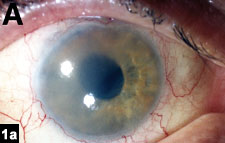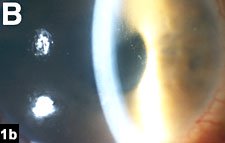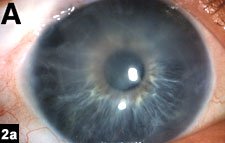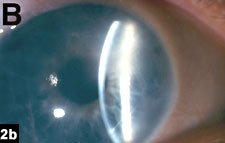Bullous keratopathy possible after trabeculectomy with mitomycin-C
Two cases suggest a compromised endothelium and mitomycin use may lead to development of the complication after glaucoma surgery.
The combination of a compromised endothelium and the use of mitomycin-C can cause bullous keratopathy in patients undergoing glaucoma filtering surgery, a recent publication suggests.
Holger Mietz, MD, and colleagues at the University of Cologne reported two cases in which bullous keratopathy developed next to a filtering bleb.
Specular microscopy showed “marked irregularities of the endothelial cells and areas of necrosis” in areas of the cornea near the filtering bleb, the authors reported.
“The two cases described here demonstrate that in cases where the corneal endothelium is already compromised before surgery, the application of mitomycin-C may have an additional toxic effect to the endothelium and may result in a partial bullous keratopathy,” Dr. Mietz and colleagues reported in Graefe’s Archive for Clinical and Experimental Ophthalmology.
They said it is important for ophthalmologists to be aware of this potential complication because use of mitomycin-C (MMC) to enhance filtering procedures has become the standard of care.
Complications associated with MMC have included shallowing of the anterior chamber, acute and chronic hypotony, and blebitis. The authors said their publication is the first description of this complication of MMC use in filtering surgery.
 At 7 months after trabeculectomy with mitomycin-C, the cornea has an epithelial edema secondary to a decrease of the endothelial cells in the superior and temporal half, while the cornea is clear in the inferior and nasal area. |  Slit-lamp view shows the same eye with epithelial edema present superiorly but a clear cornea inferiorly. |
 At 12 months, the avascular filtering bleb is seen adjacent to the peripheral iridectomy at the 10 o’clock position. |  Slit-lamp view shows epithelial edema present in the upper part with a clear cornea in the inferior. Images: Mietz H |
Two standard procedures
Both patients described in the publication had undergone routine trabeculectomy with 0.1 mL of MMC in a 0.2 mg/mL concentration administered for 3 minutes. All MMC was later removed with irrigation.
The first patient was a 62-year-old white man who had a history of chronic iritis in his right eye. He had undergone cataract surgery 17 years before the filtering surgery, as well as a YAG laser capsulotomy.
The man developed secondary glaucoma with IOP above 35 mm Hg despite topical and systemic therapies. Filtering surgery resulted in an IOP of 10 mm Hg.
Seven months after the surgery, Dr. Mietz and colleagues noticed bullous keratopathy next to the bleb site, which did not respond to an hourly regimen of dexamethasone 0.1% drops.
The second patient was a 41-year-old white man who had undergone two procedures in his right eye for congenital glaucoma when he was a child. Both procedures were performed superonasally.
A trabeculectomy with MMC was performed superotemporally for increased IOP in the right eye. Twelve months later, despite a visual acuity of 20/40 and an IOP of 19 mm Hg, the authors saw epithelial edema, thickening of the corneal stroma and Descemet’s membrane folds in the upper half of the cornea next to the site of the trabeculectomy.
Endothelial microscopy revealed that where the cornea was clear, the endothelial cells were enlarged and had regularly shaped margins with visible cell nuclei. In the area of bullous decompensation, endothelial cells had a variable size appearance and the corneal thickness varied between 0.48 and 0.5 mm.
Complication
Dr. Mietz and colleagues concluded that the bullous keratopathy seen in these two cases was caused by the MMC.
“In our two cases, we do believe that the partial bullous keratopathy was indeed caused by the application of mitomycin-C, because the areas of bullous keratopathy were directly adjacent to the site of mitomycin-C application during surgery,” they said.
There were no other postop complications, and no other surgery had been performed around the bullous keratopathy site. The surgical history of the patients suggested that they both had compromised endothelium, the authors said.
“Usually the cornea remains clear and unchanged following trabeculectomy with mitomycin-C,” they said. “It appears that this specific complication of partial bullous keratopathy may probably only occur in cases where the corneal endothelium is already attenuated.”
For more information:
- Holger Mietz, MD, can be reached at Elisenstrasse 32, 63739 Aschaffenburg, Germany; e-mail: h.mietz@augen-ab.de.
Reference:
- Mietz H, Roters S, Krieglstein GK. Bullous keratopathy as a complication of trabeculectomy with mitomycin C. Graefes Arch Clin Exp Ophthalmol. 2005;243(12):1284-1287.
- Jared Schultz is an OSN Staff Writer who covers all aspects of ophthalmology. He focuses geographically on Europe and the Asia-Pacific region.
